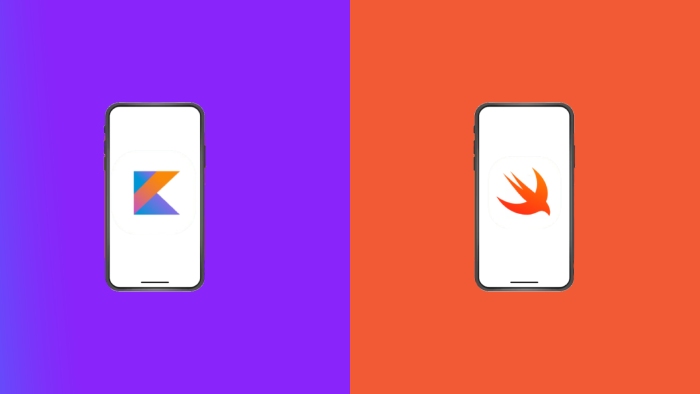In the dynamic world of mobile app development, developers constantly seek efficient solutions to bridge the gap between platforms while ensuring optimal performance and code reusability. Kotlin Multiplatform Mobile (KMM) and Swift stand out as two prominent technologies enabling developers to achieve these goals for Android and iOS platforms, respectively. In this blog post, we will delve into the intricacies of both Kotlin Multiplatform and Swift, exploring their features, advantages, and use cases to help you make informed decisions for your next mobile app project.
Difference Between Kotlin Multiplatform and Swift:
Interoperability and Brevity:
Swift, designed by Apple, emphasizes a modern approach to programming, promoting brevity and readability in code. However, while Swift excels in native iOS development, its interoperability with other platforms is limited. Conversely, Kotlin Multiplatform, built by JetBrains, embraces modern programming principles while fostering interoperability across various platforms, including iOS and Android. Kotlin’s concise syntax reduces boilerplate code, enhancing readability and reducing the likelihood of errors. Thus, Kotlin Multiplatform stands out for its ability to share code efficiently across multiple platforms, making it a compelling choice for cross-platform development.
Null Safety:
Swift introduces strong type safety and optional types to mitigate nullability issues commonly encountered in programming languages like Objective-C. By making optional types a fundamental part of its syntax, Swift reduces the risk of null reference errors, improving code stability and reliability. Similarly, Kotlin Multiplatform enforces null safety through its type system, requiring developers to explicitly handle nullable types. By discouraging null references by default, Kotlin Multiplatform minimizes the occurrence of NullPointerExceptions, leading to more robust and stable codebases. This emphasis on null safety enhances the overall quality and reliability of both Swift and Kotlin Multiplatform codebases.
Here’s an example demonstrating null safety in Kotlin Multiplatform and Swift:
Kotlin Multiplatform:
fun main() {
var name: String? = null // Nullable string
println(“Length of name: ${name?.length}”) // Safe access with null check
}
Swift:
func main() {
var name: String? = nil // Nullable string
print(“Length of name: \(name!.count)”) // Forced unwrapping (may cause runtime crash)
}
This example illustrates how Kotlin Multiplatform promotes null safety by default.
Platform-specific Features and Extensions:
Swift provides extensive access to platform-specific features and APIs, enabling developers to leverage the full capabilities of Apple’s ecosystem. Additionally, Swift supports extensions, allowing developers to add functionality to existing types without subclassing. On the other hand, Kotlin Multiplatform offers a unified development experience for iOS, Android, and web applications, enabling code sharing across platforms. While Kotlin supports extension functions similar to Swift, its focus on cross-platform compatibility provides developers with a consistent set of tools and libraries across different platforms. This approach simplifies development and maintenance efforts, making Kotlin Multiplatform an attractive choice for projects targeting multiple platforms.
Ecosystem and Community Support:
Swift benefits from strong support and investment from Apple, resulting in a robust ecosystem of libraries, frameworks, and development tools tailored specifically for iOS and macOS development. Furthermore, Swift enjoys a large and active community of developers, contributing to its ongoing evolution and improvement. Conversely, Kotlin Multiplatform, while gaining traction in the developer community, may have a smaller ecosystem compared to Swift. However, Kotlin’s compatibility with existing Java libraries and frameworks, combined with its growing adoption, indicates promising prospects for the expansion of its ecosystem. As Kotlin Multiplatform matures and gains wider adoption, its ecosystem and community support are expected to strengthen, further enhancing its appeal for cross-platform development.
Performance and Optimization:
Swift is optimized for performance, with features like automatic reference counting (ARC) and compiler optimizations contributing to efficient memory management and execution speed. Additionally, Swift’s strong typing system enables compiler optimizations that improve runtime performance. Kotlin Multiplatform, while offering competitive performance through native compilation, may face challenges in achieving the same level of optimization as Swift due to its cross-platform nature. However, Kotlin’s interoperability with native code and support for platform-specific optimizations mitigate these concerns, ensuring that Kotlin Multiplatform applications deliver satisfactory performance across different platforms.
Tooling and Development Environment:
Swift benefits from Xcode, Apple’s integrated development environment (IDE), which provides comprehensive tooling support, including code completion, debugging, and performance analysis tools. This rich development environment streamlines the iOS and macOS development workflow, enhancing developer productivity. Kotlin Multiplatform developers, on the other hand, have access to various IDEs, including Android Studio, IntelliJ IDEA, and Visual Studio Code, each offering robust support for Kotlin development. While not as tightly integrated as Xcode, these IDEs provide essential features for Kotlin development and offer a familiar environment for developers accustomed to JetBrains products.
Adoption and Industry Trends:
Swift has gained widespread adoption among iOS and macOS developers, fueled by Apple’s endorsement and promotion as the primary language for Apple platform development. The language’s popularity is further bolstered by its modern features, performance optimizations, and extensive ecosystem. Kotlin Multiplatform, while gaining traction in the developer community, may face challenges in achieving the same level of adoption as Swift, particularly outside the Android ecosystem. However, Kotlin’s versatility and potential for cross-platform development position it as a viable alternative, especially for projects requiring code sharing across multiple platforms. As industry trends continue to evolve, both Swift and Kotlin Multiplatform are likely to play significant roles in shaping the future of cross-platform development.
Which is Better for App Development?
The choice between Kotlin Multiplatform and Swift ultimately depends on your specific project requirements, team expertise, and target platforms. Swift stands out as the premier choice for iOS and macOS app development, backed by Apple’s comprehensive ecosystem of frameworks, tools, and support. Leveraging Swift ensures native experiences across Apple platforms, with access to platform-specific features and optimizations. Its performance prowess, bolstered by automatic memory management and compiler optimizations, translates into swift and responsive user experiences. Moreover, Swift benefits from a mature ecosystem, comprising libraries, frameworks, and a robust developer community, further augmenting its appeal for Apple platform development.
Conversely, Kotlin Multiplatform emerges as a compelling option for cross-platform development, facilitating code sharing across diverse platforms, including Android, iOS, and web applications. This approach significantly reduces redundancy and accelerates development cycles by maximizing code reuse. Kotlin’s seamless interoperability with existing Java codebases simplifies integration with Android projects, while its support for native platform APIs on iOS and other platforms ensures a cohesive development experience. Furthermore, Kotlin Multiplatform offers flexibility in selecting the appropriate tooling and architecture for each platform, empowering developers to tailor solutions to specific project requirements.
Ultimately, the choice between Swift and Kotlin Multiplatform hinges on project-specific factors. Swift excels in delivering native experiences for iOS and macOS apps, ideal for projects prioritizing platform integration and performance optimization. Conversely, Kotlin Multiplatform shines in scenarios necessitating cross-platform compatibility and extensive code reuse, making it an attractive proposition for projects targeting multiple platforms or seeking to streamline development efforts. Evaluating these considerations in alignment with project goals and constraints will facilitate informed decision-making in selecting the most suitable language and platform for app development.

